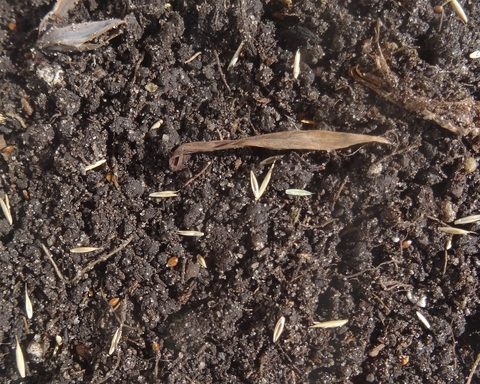November is usually not a time most people think about doing yard work, besides raking excess leaves. However, if you want to start a bee lawn, we are near the best time of year for that task.
Seeding after the current growing season is over with the intention of allowing the seed to germinate the following year is called dormant seeding (another term is frost seeding). Maybe you are unfamiliar with dormant seeding, but for many plants, it is a natural and easy way to establish them.
Dormant seeding provides the best timing for successful bee lawn establishment because it allows for germination very early in the spring before most of the annual weeds such as crabgrass have started growing.
In Minnesota, spring also is usually when there is good soil moisture for germinating seeds.
The correct time to dormant seed
Determining when in the fall to dormant seed is the trickiest part of what otherwise is an easy process. In the Twin Cities, early November to mid December is usually the best time, but it will vary each year depending on weather conditions. You must be quite sure that the seed will not germinate in the current year and it stays inert until the following spring.
For 2021 in the Twin Cities, the best time will likely begin within a week, but later than that will work as well, even if the ground becomes frozen.
What happens if you dormant seed too early in the fall? Well, those seeds might germinate if the weather gets unseasonably warm, instead of waiting until spring, and then be killed with the next frost.
You can see that timing is very important to the success of your dormant seeding. One tip is that if you have to mow your lawn because the turfgrass is still growing, it is a good sign it is too early in the fall to dormant seed.
The dormant seeding process
It might seem strange, and maybe too good to be true, to just throw down bee lawn seed on top of the ground without doing any other steps, but that is exactly how it works when you dormant seed.
The freeze-thaw cycle of our winter will work the seed into the soil as long as you have good seed-to-soil contact at the start. That means the area should not have an overly heavy residue of existing plant materials or leaf litter.
Sparse plant material, whether dead or dormant turfgrass, is fine and can also provide some soil protection to hold the seed in place. The main goal is to make sure most of the seed is touching bare soil.
If you have decided to dormant seed a bee lawn (or even a regular lawn) this year, buy your seed now and get the seed down before winter hits. You never know what weather curveballs nature will throw us in Minnesota.
For more on bee lawns, explore Planting and maintaining a bee lawn or learn about UMN research on bee lawns.


